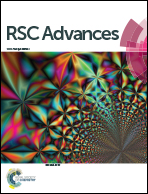First-principles calculations of graphene-based polyaniline nano-hybrids for insight of electromagnetic properties and electronic structures
Abstract
In situ polymerization between aniline and ammonium persulfate (APS) under acidic conditions is described for the preparation of graphene-based polyaniline hybrids with investigation of their electromagnetic properties. Samples were characterized by X-ray diffraction (XRD), Raman spectroscopy, Fourier transform infrared (FTIR), scanning electron microscopy (SEM), transition electron microscopy (TEM) and vector network analysis. The results revealed that the graphene-based PANI hybrids formed a uniform PANI particle coating on the graphene sheets. Such special structures lead to π–π interactions between graphene and PANI, and thus the electromagnetic absorption properties are significantly improved versus pure conducting polymers. The maximum reflection loss reaches −32.1 dB at 5.45 GHz with a thickness of 4 mm. The bandwidth (RL < −10 dB) reaches an amazing 5.62 GHz with a thickness of 2 mm. In particular, first-principles calculations based on density function theory (DFT) were carried out to uncover the relationship between dielectric properties and electronic structures.


 Please wait while we load your content...
Please wait while we load your content...